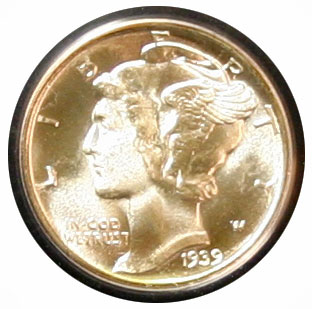In looking at some of the clippings in Adolph Weinman’s files (frame #1172), this one looked interesting even if the comment is not quite clear in today’s terminology:
In this clipping from The Daily News dated Monday, January 22, 1917, Mr. James Stewart of Chicago stated:
“All hail the government mint! In the coinage of the new 10 cent issue they have the figurehead looking toward the left. On previous coinage the head looks to the right – a ‘bar sinister’ in heraldry. All crests look to the left correctly.”
What does “bar sinister” mean?
Doing a simple definition search, the online Merriam Webster dictionary defines “bar sinister” as
1. A heraldic charge held to be a mark of bastardy
2. The fact or condition of being of illegitimate birth
Those definitions do not quite fit within Mr. Stewart’s comment about, what was then, the new dime.
Researching still further, the Encyclopedia Britannica from 1893 claims the term “bar sinister” is incorrectly applied and should be “baton sinister.”
Another article by William Armstrong Crozier listed on GeneaologyMagazine.com states:
“An erroneous impression exists in the minds of many persons, not only in America, but in Europe as well, that the bar sinister is mark of illegitimacy, and the belief is so general that we even find an author applying it as a title to one of his best known stories. As a matter of fact, there is no such thing as a bar sinister—it is an heraldic impossibility. We have the ‘bar,’ which is an honorable ordinary, formed by two parallel lines occupying a fifth part of the shield. The mark of illegitimacy is the baton sinister, which is borne over all the other charges, making it appear as though the shield had received a long narrow blot running from right to left. For the descendants of royal blood, the baton is composed entirely of metal. According to some of the old authorities, this mark should be borne by the descendants of the natural son until the third generation, when they are permitted to relinquish it and assume the original paternal coat.”
Though, C.L. Ward offered a different explanation of “bar sinister” in his comments in the New York Times of February 22, 1908. He explained:
“Of course, in English heraldry there is, and can be, no bar sinister – a bar crossing the shield horizontally- and the sign of illegitimacy is the baton, which is the bend sinister couped at both ends. But, in French heraldry the bend sinister, unaltered, is used , and is termed ‘le barre,’ from which we derive the term ‘bar sinister,’ which is thus an Anglicized Gallicism correctly used. It is as well fixed in our language as any such term can be, and no one need hesitate to use it.”
On a related note, let’s further review a couple of heraldic definitions. In A Glossary of Terms Used in Heraldry by James Parker first published in 1894, the definition for “sinister” shows the following:
Sinister, (fr. sinistre): the left hand side. As shields are always supposed to be upon the arms of the bearer, it is his left-hand side which is meant; consequently the sinister is on the spectator’s right hand.
The opposite side is known as:
Dexter: the right-hand side of the shield, being that to the left of the spectator.
But, let’s go back to Mr. Stewart’s comment of “all crests look to the left correctly.”
Another heraldry site includes descriptions about the “dexter” side being the positive side and that figures are turned that way to represent positive qualities. On the other hand, figures of slain enemies face the sinister side. Additionally, the “dexter” side is known as the “masculine” side, whereas the “sinister” is known as the “feminine” side.
Though Liberty on the Winged Liberty (Mercury) dime faces left, the position, from her viewpoint, is toward the dexter (right) side, and in the heraldic symbolism, demonstrates positive qualities.
So, what does this say about Franklin on the half dollar and Lincoln on the penny? Both of them face to the right from the viewer’s perspective but to their left side which is their “sinister” side.
In all likelihood, neither Victor D. Brenner designing the obverse of the Lincoln cent nor John Sinnock designing the Benjamin Franklin half dollar gave any thought to dexter versus sinister when they positioned the portraits on the coins.
More recently, the 2005 nickel had Jefferson facing to his sinister side. For Americans, heraldry is important from an historical view, but since we do not actively use shields and crests, the sinister versus dexter position in portraits is aesthetic rather than symbolic.
Interestingly, several of the heraldry resources claim that people in America, even in our nation’s early days, never properly used the heraldic rules and symbols in family crests anyway.
One wonders if Adolph Weinman considered dexter versus sinister when designing the dime or if he just liked the dexter version better. More research for another day.

